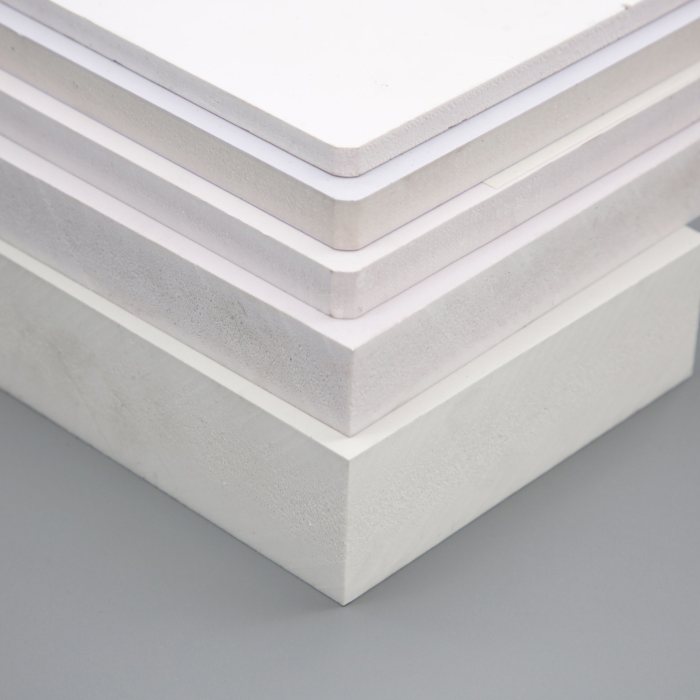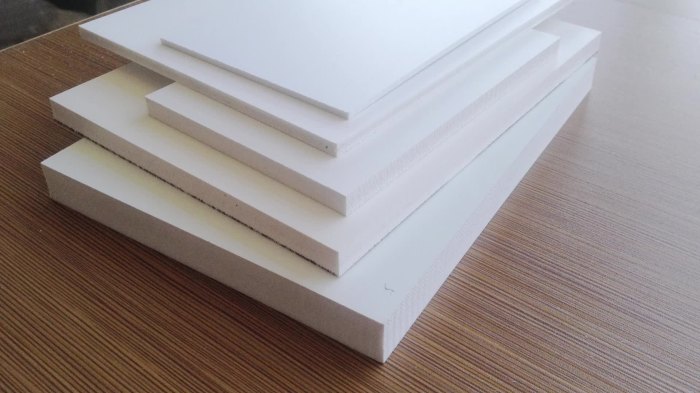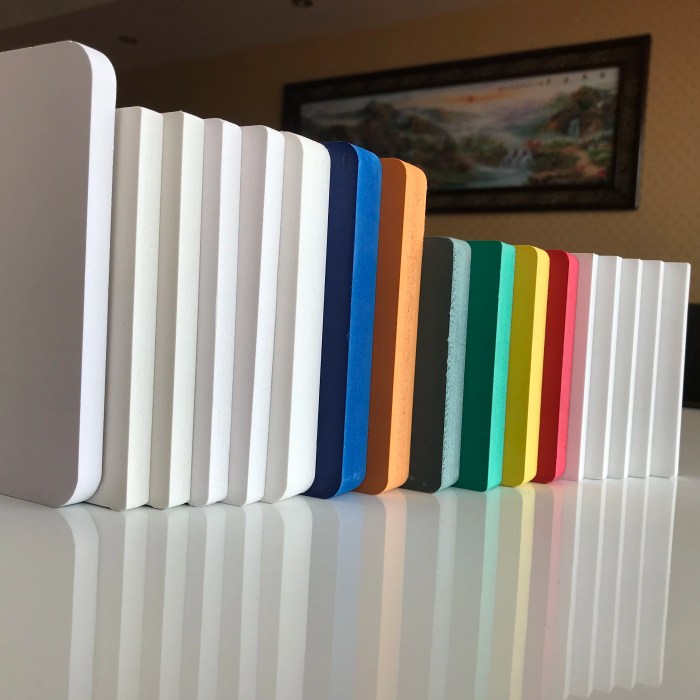PVC foam board, a remarkable material characterized by its lightweight, rigidity, and durability, takes center stage in this comprehensive guide. Delving into its unique properties, fabrication techniques, and diverse applications, we unravel the versatility of this exceptional material.
From signage and displays to construction and creative projects, PVC foam board proves its mettle in a multitude of settings. Its adaptability stems from its exceptional properties, which we explore in detail.
Properties and Characteristics of PVC Foam Board

PVC foam board is a versatile material known for its unique combination of properties. It is exceptionally lightweight, making it easy to handle and transport. Despite its low weight, PVC foam board exhibits remarkable rigidity and durability, ensuring its longevity and resistance to impact and bending.
Grades and Densities
PVC foam board is available in various grades and densities, each tailored to specific applications. Higher-density boards provide increased strength and rigidity, while lower-density boards offer greater flexibility and ease of fabrication. The choice of grade and density depends on the intended use, whether it be for signage, display, or industrial applications.
Applications
The unique properties of PVC foam board make it suitable for a wide range of applications. Its lightweight and rigidity make it ideal for signage and display purposes, both indoors and outdoors. Its durability and resistance to moisture and chemicals render it appropriate for use in industrial settings, such as for packaging and protective barriers.
Additionally, PVC foam board can be easily cut, shaped, and painted, making it a versatile material for prototyping, model making, and other creative endeavors.
Applications of PVC Foam Board
PVC foam board finds diverse applications in various industries due to its unique properties. Its lightweight, rigidity, and durability make it an ideal material for signage, displays, and construction.
In the signage industry, PVC foam board is widely used for creating eye-catching signs and displays. Its smooth surface allows for vibrant printing and easy customization. The lightweight nature of the board makes it convenient to transport and install.
Signage and Displays
- Signage for retail stores, offices, and events
- Trade show displays and exhibition booths
- Menu boards and advertising displays
- Point-of-purchase (POP) displays
PVC foam board is also an excellent choice for construction applications. Its insulation properties make it suitable for thermal insulation in buildings. Additionally, its moisture resistance and durability make it ideal for exterior cladding and roofing.
Construction
- Insulation in walls, roofs, and ceilings
- Exterior cladding and siding
- Roofing underlayment
- Partition walls and interior dividers
Beyond these traditional applications, PVC foam board is also being used in innovative and creative ways. Artists and designers are utilizing its versatility to create unique sculptures, furniture, and home décor items.
Pvc foam board is a versatile material with a wide range of applications. From construction to signage, its lightweight and durable nature make it a popular choice. While pvc foam board is an excellent option for many projects, it’s worth exploring other materials like the fresh foam x 1080 v13 for specialized needs.
However, for projects requiring rigidity, insulation, and ease of fabrication, pvc foam board remains a reliable and cost-effective solution.
Creative and Innovative Uses
- Custom furniture and décor
- Architectural models and prototypes
- Art installations and sculptures
- Cosplay and costume making
Overall, PVC foam board’s versatility and adaptability make it a valuable material across various industries and applications. Its unique properties enable businesses and individuals to create innovative and effective solutions.
Fabrication and Techniques
PVC foam board is a versatile material that can be fabricated using various techniques to achieve desired shapes and forms. These techniques include cutting, routing, and thermoforming, each requiring specific tools and equipment for optimal results.
Cutting
Cutting PVC foam board can be done using a variety of tools, including utility knives, circular saws, and CNC routers. The choice of tool depends on the thickness and density of the foam board, as well as the desired cut quality.
For thin foam boards, a sharp utility knife may suffice, while thicker boards may require a power tool for clean and precise cuts.
Routing
Routing is a process that involves using a CNC router to cut intricate shapes and designs into PVC foam board. This technique is often used for creating custom signage, displays, and other applications where precise cuts are essential. The router bit used for routing PVC foam board should be sharp and designed for cutting plastics.
Thermoforming
Thermoforming is a process that involves heating PVC foam board to a pliable state and then molding it into desired shapes using a mold or vacuum forming machine. This technique is often used for creating complex shapes and curves that would be difficult to achieve through cutting or routing.
The temperature and pressure used during thermoforming must be carefully controlled to ensure proper bonding and prevent damage to the foam board.
Safety Guidelines
When working with PVC foam board, it is important to follow proper safety guidelines to minimize the risk of injury. These guidelines include:
- Wear appropriate safety gear, including gloves, safety glasses, and a dust mask.
- Use sharp tools and equipment to prevent tearing or ragged edges.
- Secure the foam board properly before cutting or routing to prevent it from moving or vibrating.
- Avoid inhaling dust or fumes generated during cutting or routing.
Finishing and Customization

PVC foam board offers a versatile canvas for personalization and enhancements. Various finishing techniques can elevate its appearance, durability, and functionality, transforming it into unique creations.
Painting
Painting PVC foam board is a straightforward method to add color, graphics, or intricate designs. It allows for customization to match specific aesthetics or project requirements. The non-porous surface of the board ensures excellent paint adhesion, providing a smooth and vibrant finish.
Printing, Pvc foam board
Digital or screen printing techniques can produce high-quality images, logos, or text directly onto PVC foam board. This process enables the creation of durable, weather-resistant graphics that withstand fading and abrasion, making it ideal for outdoor signage or promotional displays.
Laminating
Laminating PVC foam board with a protective film or decorative overlay enhances its durability and aesthetic appeal. The laminates provide resistance to scratches, UV rays, and moisture, extending the lifespan of the board. They also offer a wide range of finishes, such as matte, glossy, or textured, to complement different design concepts.
Comparison with Alternative Materials

PVC foam board stands out among various materials due to its unique properties and versatility. When compared to other commonly used materials like wood, metal, and acrylic, it offers distinct advantages and limitations.
Understanding the strengths and weaknesses of each material is crucial for selecting the most suitable option for a specific project. Factors such as durability, cost, weight, and ease of fabrication should be carefully considered.
Wood
- Pros:Natural aesthetics, easy to work with, relatively low cost
- Cons:Susceptible to rot, moisture damage, and warping; requires regular maintenance
Metal
- Pros:Durable, strong, fire-resistant
- Cons:Heavy, expensive, prone to corrosion; requires specialized tools and techniques for fabrication
Acrylic
- Pros:Transparent, weather-resistant, lightweight
- Cons:Can be brittle, scratches easily; more expensive than PVC foam board
Concluding Remarks
In conclusion, PVC foam board stands out as a versatile and practical material, offering a myriad of possibilities for businesses and individuals alike. Its ease of fabrication, coupled with its durability and customizable nature, makes it an ideal choice for a wide range of applications.
As technology advances, we can anticipate even more innovative uses for this remarkable material.
Commonly Asked Questions
What are the advantages of using PVC foam board?
PVC foam board offers numerous advantages, including its lightweight, rigidity, durability, ease of fabrication, and resistance to moisture and chemicals.
How can PVC foam board be fabricated?
PVC foam board can be fabricated using a variety of techniques, including cutting, routing, thermoforming, and laminating.
What are the common applications of PVC foam board?
PVC foam board finds applications in signage, displays, construction, packaging, and a variety of creative projects.